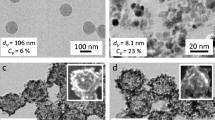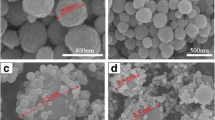Abstract
To prepare functionalized magnetic polymer particles that are thermally responsive, inverse emulsion copolymerization of N-isopropylacrylamide, N,N′-methylenebisacrylamide and glycidyl acrylate (GA) was investigated in paraffin oil in the presence of γ-Fe2O3 nanoparticles dispersed in a water/glycerol mixture. The resulting polymer particles were characterized regarding the morphology, size, polydispersity, iron content, and the temperature-dependent phase transition using optical microscopy, transmission electron microscopy, scanning electron microscopy, atomic absorption spectroscopy, and differential scanning calorimetry. Magnetic properties were examined using hysteresis loop measurements and by analyzing the magnetic susceptibility with respect to temperature. We have also investigated the influence of the concentration of γ-Fe2O3 and GA in monomers on properties of the particles (morphology, size, and presence of oxirane groups). The particles possessed a hollow structure as a result of phase separation between water/glycerol hydrophilic solvents in the polymerization feed and the forming polymer. Depending on the concentration of γ-Fe2O3 in the monomer phase, the magnetic hollow particles contained 5–24 wt% iron. In water, the particles gradually collapsed when the temperature was raised to 40 °C because the elevated temperature weakened hydration and the PNIPAAm chains gradually became more hydrophobic.












Similar content being viewed by others

References
Lou XW, Archer LA, Yang ZC (2008) Hollow micro-/nanostructures: synthesis and applications. Adv Mater 20:3987–4019.
Zhao WR, Chen HR, Li YS, Li L, Lang MD, Shi JL (2008) Uniform rattle-type hollow magnetic mesoporous spheres as drug delivery carriers and their sustained release property. Adv Funct Mater 18:2780–2788.
Xuan SH, Jiang WQ, Gong XL, Hu Y, Chen ZY (2009) Magnetically separable Fe3O4/TiO2 hollow spheres: Fabrication and photocatalytic activity. J Phys Chem C 113:553–558.
Wang DW, Zhao XP (2009) Microencapsulated electric ink using gelatin/gum arabic. J. Microencapsulation 26:37–45.
Lee J, Hong J, Park DW, Shim SE (2010) Microencapsulation and characterization of poly(vinyl alcohol)-coated titanium dioxide particles for electrophoretic display. Opt Mater 32:530–534.
Sun ZC, Bai F, Wu HM, Schmitt SK, Boye DM, Fan HY (2009) Hydrogen-bonding-assisted self-assembly: Monodisperse hollow nanoparticles made easy. J Am Chem Soc 131:13594–13595.
Okubo M, Minami H, Morikawa K (2001) Production of micron-sized, monodisperse, transformable rugby-ball-like-shaped polymer particles. Colloid Polym Sci 279:931–935.
Minami H, Kobayashi H, Okubo M (2005) Preparation of hollow polymer particles with a single hole in the shell by SaPSeP. Langmuir 21:5655–5658.
Johnston APR, Cortez C, Angelatos AS, Caruso F (2006) Layer-by-layer engineered capsules and their applications. Curr Opin Colloid In 11:203–209.
Schneider G, Decher G (2004) From functional core/shell nanoparticles prepared via layer-by-layer deposition to empty nanospheres. Nano Lett 4:1833–1839.
Okubo M, Konishi Y, Minami H (1998) Production of hollow polymer particles by suspension polymerization. Colloid Polym Sci 276:638–642.
Okubo M, Konishi Y, Minami H (2001) Influence of the kind of end groups of polystyrene on the production of hollow particles by suspension polymerization for divinylbenzene/toluene droplets dissolving them. Colloid Polym Sci 279:519–523.
Wohlgemuth M, Mächtle W, Mayer C (2000) Improved preparation and physical studies of polybutylcyanoacrylate nanocapsules. J Microencapsulation 17:437–448.
Saigal T, Dong HC, Matyjaszewski K, Tilton RD (2010) Pickering emulsions stabilized by nanoparticles with thermally responsive grafted polymer brushes. Langmuir 26:15200–15209.
Suzuki D, Kawaguchi H (2006) Janus particles with a functional gold surface for control of surface plasmon resonance. Colloid Polym Sci 284:1443–1451.
Tiarks F, Landfester K, Antonietti M (2001) Preparation of polymeric nanocapsules by miniemulsion polymerization. Langmuir 17:908–918.
Okubo M, Konishi Y, Inohara T, Minami H (2001) Production of hollow polymer particles by suspension polymerizations for divinylbenzene/toluene droplets dissolving styrene-methyl methacrylate copolymers. Macromol Symp 175:321–328.
Itou N, Masukawa T, Ozaki I, Hattori M, Kasai K (1999) Cross-linked hollow polymer particles by emulsion polymerization. Colloid Surface A 153:311–316.
Yuan JJ, Zhou TA, Pu HT (2010) Nano-sized silica hollow spheres: preparation, mechanism analysis and its water retention property. J Phys Chem Solids 71:1013–1019.
Meng YD, Chen DR, Jiao XL (2008) Synthesis and characterization of CoFe2O4 hollow spheres. Eur J Inorg Chem 2008:4019–4023.
Sakanishi K, Hasuo H, Mochida I, Okuma O (1995) Preparation of highly dispersed NiMo catalysts supported on hollow spherical carbon-black particles. Energ Fuel 9:995–998.
Li HM, Wang MZ, Song LY, Ge XW (2008) Uniform chitosan hollow microspheres prepared with the sulfonated polystyrene particles templates. Colloid Polym Sci 286:819–825.
Nayak S, Gan DJ, Serpe MJ, Lyon LA (2005) Hollow thermoresponsive microgels. Small 1:416–421.
Guo J, Yang WL, Deng YH, Wang CC, Fu SK (2005) Organic-dye-coupled magnetic nanoparticles encaged inside thermoresponsive PNIPAM microcapsutes. Small 1:737–743.
Reis AV, Guilherme MR, Mattoso LHC, Rubira AF, Tambourgi EB, Muniz EC., (2009) Nanometer- and submicrometer-sized hollow spheres of chondroitin sulfate as a potential formulation strategy for anti-inflammatory encapsulation. Pharm Res 26:438–444.
Heskins M, Guillet EJ (1968) Solution properties of poly(N-isopropylacrylamide). J Macromol Sci Chem (A) 2:1441–1445.
Shibayama M, Isono K, Okabe S, Karino T, Nagao M. (2004) SANS study on pressure-induced phase separation of poly(N-isopropylacrylamide) aqueous solutions and gels. Macromolecules 37:2909–2918.
Okamura A, Hagiwara T, Yamagami S, Yamaguchi M, Shinbo T, Kanamori T, Kondo S, Miwa K, Itagaki I (2008) Effective cell separation utilizing poly(N-isopropylacrylamide)-grafted polypropylene membrane containing adsorbed antibody. J Biosci Bioeng 105:221–225.
Lee CF, Lin CC, Chien CA, Chiu WY (2008) Thermosensitive and control release behavior of poly(N-isopropylacrylamide-co-acrylic acid)/nano-Fe3O4 magnetic composite latex particle that is synthesized by a novel method. Eur Polym J 44:2768–2776.
Yamada N, Okano T, Sakai H, Karikusa F, Sawasaki Y, Sakurai Y (1990) Thermo-responsive polymeric surfaces-control attachment and detachment of cultured cells. Macromol Chem Rapid Commun 11:571–576.
Takahashi H, Nakayama M, Itoga K, Yamato M, Okano T (2011) Micropatterned thermoresponsive polymer brush surfaces for fabricating cell sheets with well-controlled orientational structures. Biomacromolecules 12:1414–1418.
Novotná L, Emmerová T, Horák D, Kučerová Z, Tichá M (2010) Iminodiacetic acid-modified magnetic poly(2-hydroxyethyl methacrylate)-based microspheres for phosphopeptide enrichment. J Chromatogr A 1217:8032–8040.
Kaman O, Veverka P, Jirak Z, Marysko M, Knizek K, Veverka M, Kaspar P, Burian M, Sepelak V, Pollert E (2011) The magnetic and hyperthermia studies of bare and silica-coated La0.75Sr0.25MnO3 nanoparticles. J Nanopart Res 13:1237–1252.
Overberger CG, O’Shaughnessy MT, Shalid H (1949) The preparation of some aliphatic azo nitriles and their decomposition in solution. J Am Chem Soc 71:2661–2666.
Babič M, Horák D, Trchová M, Jendelová P, Glogarová K, Lesný P, Herynek V, Hájek M, Syková E (2008) Poly(l-lysine)-modified iron oxide nanoparticles for stem cell labeling. Bioconjugate Chem 19:740–750.
Hrouda F (1994) A technique for the measurement of thermal-changes of magnetic-susceptibility of weakly magnetic rocks by the CS-2 apparatus and KLY-2 kappabridge. Geophys J Int 118:604–612.
Feeney PJ, Napper DH, Gilbert RG (1984) Coagulative nucleation and particle-size distributions in emulsion polymerization. Macromolecules 17:2520–2529.
Dunlop D, Ozdemir O (1997) Rock magnetism: Fundamentals and frontiers. Cambridge University Press, New York.
Petrovský E, Kapička A (2006) On determination of the Curie point from thermomagnetic curves. J Geophys Res 111:B12S27
Macková H, Králová D, Horák D (2007) Magnetic poly(N-isopropylacrylamide) microspheres by dispersion and inverse emulsion polymerization. J Polym Sci, Part A: Polym Chem 45:5884–5898.
Ugelstad J, Berge A, Ellingsen T, Schmidt R, Nilsen T-N, Mork PC, Stenstad P, Bornea E, Olsvik O (1992) Preparation and application of new monosized polymer particles. Prog Polym Sci 17:87–161.
Elaissari A (2003) Colloid polymers: Synthesis and characterization. Marcel Dekker, New York, USA.
Gil ES, Hudson SA (2004) Stimuli-reponsive polymers and their bioconjugates. Prog Polym Sci 29:1173–1222.
Hrubý M, Kučka J, Lebeda O, Macková H, Babič M, Koňák Č, Studenovský M, Sikora A, Kozempl J, Ulbrich K (2007) New bioerodable thermoresponsive polymers for possible radiotherapeutic applications. J Controll Release 119:25–33.
Acknowledgments
The financial support of the European Union (grant DiaTools no. 259796), Grant Agency of the Czech Republic (grant P503/10/0664) and Academy of Sciences of the Czech Republic (grant KAN401220801) is gratefully acknowledged.
Author information
Authors and Affiliations
Corresponding author
Rights and permissions
About this article
Cite this article
Macková, H., Horák, D., Petrovský, E. et al. Magnetic hollow poly(N-isopropylacrylamide-co-N,N′-methylenebisacrylamide-co-glycidyl acrylate) particles prepared by inverse emulsion polymerization. Colloid Polym Sci 291, 205–213 (2013). https://doi.org/10.1007/s00396-012-2609-y
Received:
Revised:
Accepted:
Published:
Issue Date:
DOI: https://doi.org/10.1007/s00396-012-2609-y



